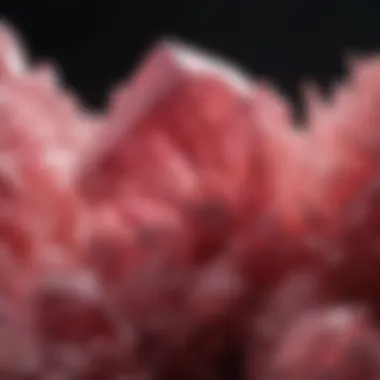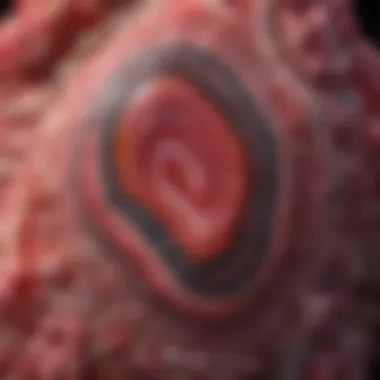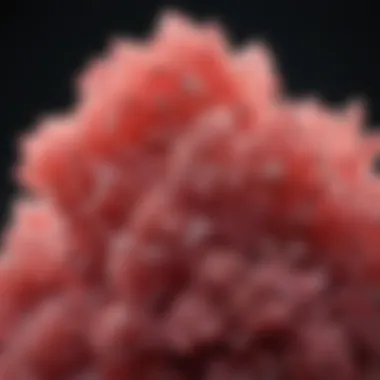Unraveling the Enigmatic Charm of Rhodochrosite Specimens: A Geological Masterpiece


Rock and Fossil Identification
Rhodochrosite specimens are esteemed for their hypnotic allure, characterized by their captivating hues and intricate formations. As collectors venture into the realm of geological treasures, identifying these unique specimens becomes a paramount task. Rhodochrosite derives its name from the Greek words 'rhodon' meaning rose and 'chros' meaning color, alluding to its distinctive pink to rose-red tones. The key characteristics to look for in rhodochrosite specimens include their rich color saturation, intricate banding patterns, and a smooth, glassy luster. Utilizing tools like magnifying glasses, UV lights, and hardness picks aids in the accurate identification of these prized geological wonders.
Collecting Tips and Techniques
For enthusiasts seeking to add rhodochrosite specimens to their collection, understanding the best practices for collecting is essential. Locating prime collecting sites where rhodochrosite can be found in abundance requires meticulous research and exploration. These specimens are often discovered in association with silver, lead, and copper ores. To safely extract rhodochrosite specimens without causing damage, employing tools like rock hammers, chisels, and safety goggles is imperative. Gentle techniques such as hand-collecting and using soft brushes for cleaning ensure the preservation of these delicate formations.
Preservation and Display
Preserving the pristine beauty of rhodochrosite specimens involves employing effective techniques and proper storage methods. To prevent discoloration and degradation, these specimens should be shielded from prolonged exposure to light and moisture. Storing rhodochrosite in padded containers or display cases with cushioned interiors protects them from scratches and impacts. Creative display ideas include arranging specimens on backlit shelves to enhance their translucent qualities or framing them in shadow boxes for a striking visual presentation.
Geological Insights
Delving deeper into the origins of rhodochrosite unveils its intriguing geological formations and processes. These specimens primarily form in hydrothermal veins, often evolving alongside ores like sulfides and quartz. The historical significance of rhodochrosite stems from its association with love, compassion, and emotional healing in metaphysical beliefs. Notable discoveries of rhodochrosite specimens with exceptional size or color intensity have sparked awe among geologists and collectors alike, shining a spotlight on the mystique of these enchanting geological marvels.
Introduction
Rhodochrosite specimens hold a unique allure in the world of geological treasures, captivating enthusiasts with their mesmerizing hues and distinctive formations. This article embarks on an exploration of the mystique surrounding rhodochrosite, shedding light on its origin, characteristics, significance to collectors, and preservation techniques. As a prized possession for rock and fossil collectors, the significance of understanding rhodochrosite lies in unraveling the geological marvel that it is.
What is Rhodochrosite?
Rhodochrosite, a manganese carbonate mineral, possesses a composition and structure that influence its appearance and desirability among collectors. The intricate formation of rhodochrosite crystals contributes to its stunning aesthetic appeal, making it a sought-after specimen in geological collections.


Composition and Structure
The composition of rhodochrosite, characterized by its manganese carbonate content, plays a pivotal role in defining the mineral's physical properties and coloration. This composition gives rhodochrosite its distinct pink to red hues, mesmerizing collectors with its vibrant color spectrum. The intricate crystalline structure of rhodochrosite further enhances its visual appeal, showcasing unique patterns and formations that showcase nature's artistry.
Color Variations
Rhodochrosite exhibits a range of color variations, from delicate pink to rich red tones, influenced by trace elements during its formation process. These color variations add depth and complexity to rhodochrosite specimens, creating a visual charm that entices collectors worldwide. Understanding the nuances of color variations in rhodochrosite enhances appreciation for its beauty and rarity in the realm of geological treasures.
Origin and Formation
Rhodochrosite is a captivating mineral with a rich history that dates back millions of years. Understanding the origin and formation of rhodochrosite is crucial in unraveling the mysteries behind this exquisite gemstone. The geological processes that led to the creation of rhodochrosite specimens are complex and fascinating, offering a glimpse into the earth's dynamic evolution. By delving into the origin and formation of rhodochrosite, collectors can gain a deeper appreciation for the intricate beauty locked within each specimen.
Geological Context
Formation Process
The formation process of rhodochrosite is a meticulous dance between mineral elements and environmental conditions. Over thousands of years, rhodochrosite crystals slowly grow within the earth's depths, forming intricate patterns and structures that mesmerize collectors worldwide. This meticulous formation process results in the unique crystal formations that define rhodochrosite specimens, making them highly sought after in the world of geological treasures.
Occurrence in Nature
The occurrence of rhodochrosite in nature is a rare and precious phenomenon, typically found in association with other minerals in specific geological settings. The unique geological conditions necessary for rhodochrosite's formation contribute to its scarcity and beauty. Rhodochrosite's occurrence in nature provides insight into the earth's geological history, unveiling the intricate processes that have shaped these stunning specimens over millennia.
Characteristics of Rhodochrosite


Rhodochrosite's characteristics play a pivotal role in this article, shedding light on the distinct features that make it a captivating geological specimen. Understanding the composition, structure, and color variations of rhodochrosite is crucial for enthusiasts and collectors in appreciating its allure and value. The composition of rhodochrosite, marked by its manganese carbonate makeup, contributes to its vivid coloration and unique aesthetic appeal. Furthermore, delving into the structure of rhodochrosite unveils intricate patterns and formations that enhance its overall beauty. The color variations exhibited by different rhodochrosite specimens add to their mystique, ranging from delicate pinks to vibrant reds, creating a visual spectacle that mesmerizes admirers.
Crystal Forms and Patterns
Rhombic Crystals
Rhombic crystals, a distinctive feature of rhodochrosite, hold paramount importance in enriching the overall allure of this mineral. Their geometric precision and symmetrical arrangement add a sense of elegance and sophistication to rhodochrosite specimens. The unique facet of rhombic crystals lies in their ability to reflect light, creating a mesmerizing play of colors and enhancing the visual appeal of the mineral. Collectors and enthusiasts value rhombic crystals for their aesthetic charm and structural integrity, making them a sought-after choice in the realm of geological treasures.
Botryoidal Growth
Botryoidal growth patterns observed in rhodochrosite specimens provide a fascinating insight into the mineral's formation process and geological history. The rounded, globular shapes reminiscent of grape clusters offer a whimsical charm to the specimens, making them intriguing additions to any collection. Botryoidal growth showcases the organic development of rhodochrosite, with layers of mineral deposits forming intricate patterns that captivate the eye. While some may find botryoidal growth less structured compared to other crystal forms, its organic appeal and unique texture make it a valuable and distinctive inclusion in the world of rhodochrosite specimens.
Significance to Collectors
Rhodochrosite holds a significant allure for collectors in the realm of geological treasures, captivating enthusiasts with its mesmerizing hues and unique formations. Collectors are drawn to the distinctiveness of each specimen, as rhodochrosite showcases a spectrum of colors ranging from delicate pink to vibrant red. The rarity and exclusivity of well-formed rhodochrosite crystals further enhance their appeal, making them coveted additions to any geological collection. Beyond their visual charm, these specimens also hold geological and mineralogical value, showcasing intricate patterns and formations that spark fascination among collectors. The allure of rhodochrosite lies not only in its aesthetic appeal but also in its geological significance, making it a prized possession for collectors seeking both beauty and substance.
Aesthetic Appeal
Color Spectrum
The color spectrum exhibited by rhodochrosite specimens plays a pivotal role in their desirability among collectors. From soft pastel pinks to deep crimson reds, the range of colors found in rhodochrosite captivates collectors and adds diversity to their collections. The unique pink and red hues of rhodochrosite are rarely found in other minerals, making these specimens stand out in any display. The vibrant colors of rhodochrosite are not only visually appealing but also symbolize love, compassion, and creativity, adding a symbolic layer to their aesthetic appeal. Despite their beauty, the color variations in rhodochrosite can also serve as indicators of mineral impurities or geological processes, offering collectors insights into the specimen's formation history.
Inclusions and Banding


Inclusions and banding further enhance the beauty and allure of rhodochrosite specimens, adding intricacy and character to each piece. Inclusions, such as other minerals or gas bubbles trapped within the rhodochrosite matrix, create unique patterns and textures that make each specimen distinctive. Banding, which manifests as alternating layers of different colors or textures within the crystal structure, adds a mesmerizing complexity to rhodochrosite specimens, drawing collectors deeper into their aesthetic charm. While inclusions and banding contribute to the visual appeal of rhodochrosite, they also serve as indicators of the mineral's environment of formation, offering collectors clues about the geological processes that shaped these captivating specimens.
Preservation Techniques
Preservation Techniques play a pivotal role in safeguarding the allure and quality of rhodochrosite specimens. It is imperative to understand the significance of preserving these geological treasures to maintain their aesthetic appeal and value for collectors. By implementing proper preservation techniques, enthusiasts can ensure the longevity and pristine condition of their rhodochrosite specimens. This section will delve into essential preservation methods, highlighting key practices and considerations for effectively caring for these precious gemstones.
Caring for Rhodochrosite
Caring for Rhodochrosite encompasses a range of essential practices to retain the beauty and integrity of these specimens. Two primary aspects of caring for rhodochrosite include Storage Tips and Cleaning and Maintenance, each playing a crucial role in preserving the gemstones' allure and longevity.
Storage Tips
Storage Tips are fundamental in ensuring the safety and longevity of rhodochrosite specimens. Proper storage is essential to protect the specimens from external factors such as light, moisture, and physical damage. Utilizing acid-free tissue paper or soft cloth for wrapping the specimens can prevent scratches and maintain their luster. Storing rhodochrosite in a cool, dry place away from direct sunlight is recommended to avoid color fading and discoloration. By following appropriate storage techniques, collectors can safeguard the quality and beauty of their prized rhodochrosite specimens.
Cleaning and Maintenance
Cleaning and Maintenance are essential aspects of caring for rhodochrosite specimens to ensure their continued radiance and appeal. Regular cleaning with a soft, damp cloth is recommended to remove dust and dirt gently. Avoid using harsh chemicals or abrasive cleaning agents that can damage the surface of the specimens. Additionally, inspecting the specimens periodically for any signs of damage or deterioration is crucial for prompt maintenance. By incorporating proper cleaning and maintenance practices, collectors can uphold the exquisite beauty of their rhodochrosite specimens for years to come.
Famous Rhodochrosite Specimens
In the realm of geological treasures, Famous Rhodochrosite Specimens hold a prominent position due to their singular allure and captivating beauty. These specimens, revered by collectors worldwide, showcase the mesmerizing hues and unique formations that make rhodochrosite a highly sought-after gemstone. The significance of Famous Rhodochrosite Specimens lies in their rarity, exceptional visual appeal, and the stories they carry within their intricate patterns.
Notable Collections
Museum Exhibits
Museum Exhibits play a vital role in preserving and showcasing Famous Rhodochrosite Specimens to the public. These curated displays offer a glimpse into the geological wonders of rhodochrosite, highlighting the exquisite craftsmanship and natural artistry of each specimen. The key characteristic of Museum Exhibits is their ability to educate and inspire visitors, fostering a deeper appreciation for the beauty and complexity of rhodochrosite. Their advantage lies in providing a platform for researchers, enthusiasts, and the general public to witness firsthand the magnificence of Famous Rhodochrosite Specimens. While Museum Exhibits offer a wealth of information and visual appeal, their limitation may lie in accessibility, as not all collectors may have the opportunity to view these specimens up close.
Private Collections
Private Collections serve as exclusive treasure troves of Famous Rhodochrosite Specimens, offering enthusiasts a more personalized and intimate experience with these precious gemstones. The key characteristic of Private Collections is their curated selection of rare and exceptional rhodochrosite specimens, meticulously acquired and cared for by passionate collectors. These collections provide a sense of exclusivity and luxury, allowing individuals to enjoy the beauty of rhodochrosite in the comfort of their own spaces. The unique feature of Private Collections is their ability to cater to specific preferences and interests, catering to the diverse tastes of collectors. While Private Collections offer a sense of ownership and connection to Famous Rhodochrosite Specimens, their downside may be limited accessibility to the general public, creating a sense of mystery and intrigue around these coveted gemstones.







